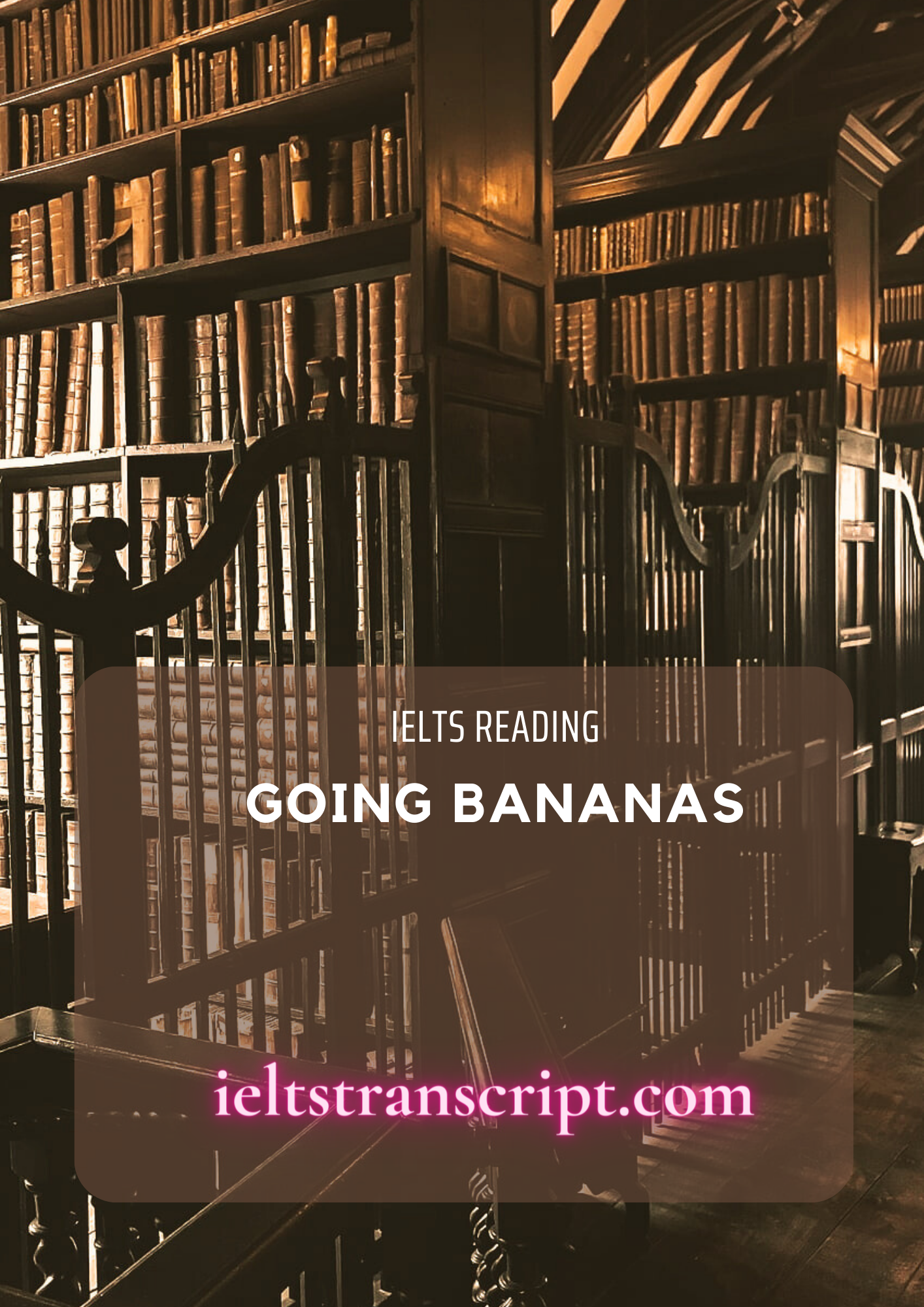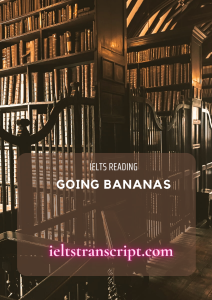- Đối với sản phẩm có giá: Sau khi chúng tôi ghi nhận thông tin đã thanh toán sản phẩm của bạn, sản phẩm sẽ được mở khóa và bạn có thể xem trực tiếp và tải tài liệu sản phẩm.
- Đối với thành viên trả phí: Bạn có thể mua và thanh toán sản phẩm với giá 0đ để tải tài liệu sản phẩm.
- Bạn có thể liên hệ với chúng tôi để được hỗ trợ mở khóa sản phẩm sớm nhất.
Going Bananas
- Chúng tôi chấp nhận các phương thức thanh toán sau đây: Thẻ tín dụng, thẻ ghi nợ, PayPal, chuyển khoản ngân hàng và tiền mặt.
Chúng tôi sẽ không thu thêm phí cho bất kỳ hình thức thanh toán nào.
- Nếu bạn gặp vấn đề về sản phẩm của chúng tôi trong thời gian sử dụng, vui lòng liên hệ với chúng tôi để được hỗ trợ xử lý sớm nhất nhé.
Xem trước mẫu
Going Bananas
The world’s favourite fruit could disappear forever in 10 years’ time
The banana is among the world’s oldest crops. Agricultural scientists believe that the first edible banana was discovered around ten thousand years ago. It has been at an evolutionary standstill ever since it was first propagated in the jungles of South-East Asia at the end of the last ice age. Normally the wild banana, a giant jungle herb called Musa acuminata, contains a mass of hard seeds that make the fruit virtually inedible. But now and then, hunter- gatherers must have discovered rare mutant plants that produced seedless, edible fruits. Geneticists now know that the vast majority of these soft-fruited I plants resulted from genetic accidents that gave their cells three copies of each chromosome instead of the usual two. This imbalance prevents seeds and pollen from developing normally, rendering the mutant plants sterile. And that is why some scientists believe the world’s most popular fruit could be doomed. It lacks the genetic diversity to fight off pests and diseases that are invading the banana plantations of Central America and the smallholdings of Africa and Asia alike.
In some ways, the banana today resembles the potato before blight brought famine to Ireland a century and a half ago. But “it holds a lesson for other crops, too,” says Emile Frison, top banana at the International Network for the Improvement of Banana and Plantain in Montpellier, France. “The state of the banana,” Frison warns, “can teach a broader lesson: the increasing standardisation of food crops round the world is threatening their ability to adapt and survive.”
The first Stone Age plant breeders cultivated these sterile freaks by replanting cuttings from their stems. And the descendants of those original cuttings are the bananas we still eat today. Each is a virtual clone, almost devoid of genetic diversity. And that uniformity makes it ripe for disease like no other crop on Earth. Traditional varieties of sexually reproducing crops have always had a much broader genetic base, and the genes will recombine in new arrangements in each generation. This gives them much greater flexibility in evolving responses to disease – and far more genetic resources to draw on in the face of an attack. But that advantage is fading fast, as growers increasingly plant the same few, high-yielding varieties. Plant breeders work feverishly to maintain resistance in these standardised crops. Should these efforts falter, yields of even the most productive crop could swiftly crash. “When some pest or disease comes along, severe epidemics can occur,” says Geoff Hawtin, director of the Rome-based International Plant Genetic Resources Institute.
The banana is an excellent case in point. Until the 1950s, one variety, the Gros Michel, dominated the world’s commercial banana business. Found by French botanists in Asia in the 1820s, the Gros Michel was by all accounts a fine banana, richer and sweeter than today’s standard banana and without the latter’s bitter aftertaste when green. But it was vulnerable to a soil fungus that produced a wilt known as Panama disease. “Once the fungus gets into the soil, it remains there for many years. There is nothing farmers can do. Even chemical spraying won’t get rid of it,” says Rodomiro Ortiz, director of the International Institute for Tropical Agriculture in Ibadan, Nigeria. So plantation owners played a running game, abandoning infested fields and moving to “clean” land – until they ran out of clean land in the 1950s and had to abandon the Gros Michel. Its successor, and still the reigning commercial king, is the Cavendish banana, a 19th-century British discovery from southern China. The Cavendish is resistant to Panama disease and, as a result, it literally saved the international banana industry. During the 1960s, it replaced the Gros Michel on supermarket shelves. If you buy a banana today, it is almost certainly a Cavendish. But even so, it is
...Chặng đường gian nan của chuối
Một loại trái cây được ưa chuộng trên toàn thế giới có thể biến mất vĩnh viễn sau 10 năm nữa
Chuối là một trong những cây trồng lâu đời nhất trên thế giới. Các nhà khoa học nông nghiệp tin rằng loại chuối ăn được đầu tiên được phát hiện cách đây khoảng 10.000 năm. Chuối đã đến giai đoạn ngừng tiến hóa kể từ khi được nhân giống lần đầu tiên trong các khu rừng rậm Đông Nam Á vào cuối kỷ băng hà cuối cùng. Thông thường, chuối dại, một loại thảo mộc rừng khổng lồ được gọi là Musa acuminata, chứa một khối lượng hạt cứng lớn khiến trái cây hầu như không thể ăn được. Nhưng đôi khi, những người săn bắt hái lượm chắc hẳn đã phát hiện ra những loài cây đột biến hiếm gặp tạo ra quả không hạt, có thể ăn được. Các nhà di truyền học giờ đây biết rằng phần lớn các loại cây có quả mềm này là do đột biến di truyền tạo ra cho tế bào của chúng ba bản sao của mỗi nhiễm sắc thể thay vì hai như thông thường. Sự mất cân bằng này khiến hạt và phấn hoa không thể phát triển bình thường, làm cho cây đột biến vô sinh. Và đó là lý do tại sao một số nhà khoa học tin rằng loại trái cây phổ biến nhất thế giới có thể bị diệt vong. Nó thiếu sự đa dạng di truyền để chống lại sâu bọ và các bệnh dịch đang xâm nhập vào các đồn điền trồng chuối ở Trung Mỹ và trang trại nhỏ ở châu Phi, châu Á.
Về mặt nào đó, chuối ngày nay giống với cây khoai tây trước khi bệnh bạc lá gây ra nạn đói cách đây một thế kỷ rưỡi tại Ireland. Nhưng “đó cũng là một bài học cho các loại cây trồng khác,” Emile Frison, người đứng đầu phụ trách về chuối tại Mạng lưới Quốc tế về phát triển Chuối và Plantain ở Montpellier, Pháp cho biết. Frison cảnh báo “Tình trạng của chuối hiện tại có thể đem đến một bài học lớn hơn: việc tiêu chuẩn hóa ngày càng cao các loại cây lương thực trên khắp thế giới đang đe dọa khả năng thích nghi và tồn tại của chúng”.
Những người lai tạo thực vật từ thời kỳ đồ đá đầu tiên đã trồng những cây biến dị vô sinh này bằng cách trồng lại cành cắt ra từ thân của chúng. Và hậu duệ của những nhánh cây được cắt đó chính là những quả chuối mà chúng ta vẫn ăn ngày nay. Mỗi cây là một bản sao thực sự, hầu như không có sự đa dạng di truyền. Và sự đồng nhất đó khiến chúng dễ bị nhiễm bệnh, không như các loại cây trồng khác trên trái đất. Các giống truyền thống của cây trồng sinh sản hữu tính luôn có cơ sở di truyền rộng hơn nhiều và các gen sẽ tái tổ hợp theo cách sắp xếp mới ở mỗi thế hệ. Điều này khiến chúng có sự linh hoạt lớn hơn nhiều trong việc tiến hóa đối phó với bệnh tật – và có nhiều nguồn gen hơn để ứng phó khi đối mặt với một cuộc tấn công. Nhưng lợi thế đó đang dần nhanh chóng biến mất, khi người nông dân tăng cường trồng một số giống nhất định cho năng suất cao. Các nhà nhân giống thực vật làm việc không ngừng nghỉ để duy trì sức đề kháng ở những giống cây trồng tiêu chuẩn hóa này. Nếu những nỗ lực này bị chùn bước, ngay cả sản lượng của các loại cây trồng có năng suất cao nhất cũng có thể nhanh chóng sụt giảm. Geoff Hawtin, Giám đốc Viện Tài nguyên Di truyền Thực vật Quốc tế có trụ sở tại Rome cho biết: “Khi một số loại sâu bệnh xuất hiện, dịch bệnh nghiêm trọng có thể xảy ra.
Chuối chính là một ví dụ tiêu biểu cho nhận định này. Cho đến những năm 1950, giống chuối Gros Michel, đã thống trị thị trường kinh doanh chuối thương mại trên thế giới. Được các nhà thực vật học người Pháp tìm thấy ở châu Á vào những năm 1820, Gros Michel được đánh giá là một loại chuối ngon, đậm đà, ngọt hơn chuối tiêu chuẩn ngày nay và không có hậu vị đắng khi còn xanh. Nhưng chúng rất dễ bị tổn thương bởi một loại nấm đất gây ra bệnh héo rũ được gọi là bệnh Panama. “Một khi nấm này xâm nhập vào đất, chúng tồn tại ở đó trong nhiều năm. Người nông dân không thể làm được gì. Ngay cả việc phun thuốc trừ sâu hóa học cũng không thể loại bỏ được chúng.” Rodomiro Ortiz, Giám đốc Viện Nông nghiệp Nhiệt đới Quốc tế ở Ibadan, Nigeria, cho biết Vì vậy các chủ đồn điền đã chơi trò chơi chạy trốn, từ bỏ những cánh đồng bị nhiễm và chuyển đến khu đất “sạch” – cho tới khi họ
...Để xem được đầy đủ nội dung và tải dữ liệu, bạn phải trở thành thành viên của chúng tôi và trả phí cho tài liệu (nếu có)











